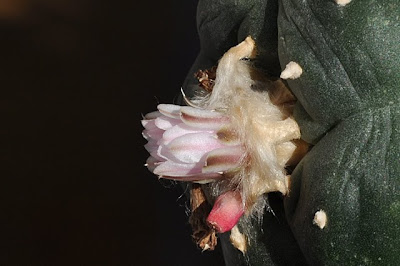A week ago my grafted Lophophora williamsii (SB 854; Starr Co, Texas) celebrated its 6th anniversary sitting on top a sturdy Trichocereus pachanoi stock. The plant was grafted as a tiny seedling and in 6 years the main head has grown to a width of approximately 8 cm (~3.2'') – the 3 largest offshoots are 6 cm (~2.4'') wide each. The main head seems to have stabilized at 8 ribs while the largest pups are in transition from 5 to 8 ribs.

Lophophora williamsii graft, top view
The last couple of weeks the plant has “popped out” fruits resulting from last years late flowers. This season’s first flower appeared a couple of days ago and was promptly (self-)pollinated – according to previous experience this should result in another fruit in 7-8 weeks time.

Grafted Lophophora williamsii, first flower of the season

Lophophora williamsii flower and fruit
I’ve already harvested more than 120 seeds from this plant alone this season. As this variety of Lophophora williamsii is not particularly frost hardy I’m not sure if I’ll start all these seeds as the seedlings will have to go to my coldhouse – maybe I should set up a “swap shop” instead ;-)

Lophophora williamsii fruits
I’m wondering for how long the Trichocereus pachanoi stock will be able to support the rather large Lophophora williamsii scion. This is my oldest graft so I have no experience to rely on regarding the actual longevity of Trichocereus stock plants; I guess time will tell.

Lophophora williamsii grafted on Trichocereus pachanoi stock
For comparison you can check the posts on the same graft as one, two, three, four, and five years old.
The American midland naturalist. 1928-29 v. 11 (added: 10/27/2025)
-
*Publication Info:*
Notre Dame, Ind., University of Notre Dame.
*Call Number:*
QK1 .A423
*Contributing Library:*
Missouri Botanical Garden
1 day ago



















Fantastic your blog and this grafted lophophora. do you think this is a good way to improve the seed production? i see you have this plant for six years, trere are more flowers in a graffted lophophora than in no grafted?
ReplyDeleteDrach, thanks for the kind words ;-) Grafting is an eminent way of seriously increasing the growth rate of Lophophora and other slow growing cacti - this plant flowered for the first time less than one and a half years after being started from seed. The enhanced growth also induces many offshoots - the first of which flowered slightly more than three years after grafting the plant. Today the main head and the 3 largest pups are flowering freely all during the growing season, producing lots of seeds. So yes, if you want to produce many seeds grafting is definitely the way to go ;-)
ReplyDeleteIncredible results¡¡, in fact last year i grafted one lophophora in a pachanoi, but it was in october and now is starting. I have a slow growing collection because i don't like to use many fertilizer but i thought about this to produce more seeds in some mother plants and then i find your page, thank you very much for your answer. I'll tell you about experience.
ReplyDeleteI'm looking forward to hear more about your results. I'm working to increase my collection of Trans-Pecos peyote and busy grafting Lophophora williamsii var. echinata seedlings, the future mother plants. The echinata variety of peyote is more tolerant to frost than the regular variety and more suitable for the climate I live in (or at least for my experiments with growing peyote in an unheated greenhouse ;-)
ReplyDeleteany chance of updated pics? im really interested in your grafts and am considering grafting a few Lophophora williamsii and Lophophora williamsii v. caespitosa to a couple of my 2 foot tall T. pachanoi to see how fast they grow :)
ReplyDeleteSean, I've been otherwise preoccupied lately ;-) ... posting updates on my grafted plants is on my to-do list ;-)
ReplyDelete